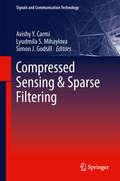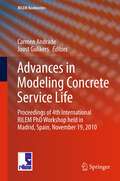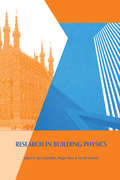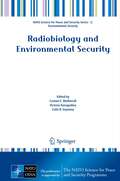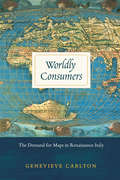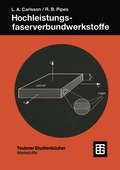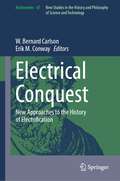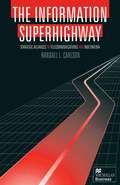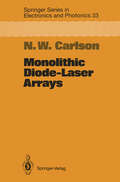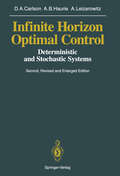- Table View
- List View
Compressed Sensing & Sparse Filtering (Signals and Communication Technology)
by Avishy Y. Carmi Lyudmila S. Mihaylova Simon J. GodsillThis book is aimed at presenting concepts, methods and algorithms ableto cope with undersampled and limited data. One such trend that recently gained popularity and to some extent revolutionised signal processing is compressed sensing. Compressed sensing builds upon the observation that many signals in nature are nearly sparse (or compressible, as they are normally referred to) in some domain, and consequently they can be reconstructed to within high accuracy from far fewer observations than traditionally held to be necessary. Apart from compressed sensing this book contains other related approaches. Each methodology has its own formalities for dealing with such problems. As an example, in the Bayesian approach, sparseness promoting priors such as Laplace and Cauchy are normally used for penalising improbable model variables, thus promoting low complexity solutions. Compressed sensing techniques and homotopy-type solutions, such as the LASSO, utilise l1-norm penalties for obtaining sparse solutions using fewer observations than conventionally needed. The book emphasizes on the role of sparsity as a machinery for promoting low complexity representations and likewise its connections to variable selection and dimensionality reduction in various engineering problems. This book is intended for researchers, academics and practitioners with interest in various aspects and applications of sparse signal processing.
Advances in Modeling Concrete Service Life: Proceedings of 4th International RILEM PhD Workshop held in Madrid, Spain, November19, 2010 (RILEM Bookseries #3)
by Carmen Andrade and Joost GulikersIn this book, a critical analysis is made on service life models related to reinforcement corrosion. The contributors are on the frontier of knowledge in the field of durability of reinforced concrete. Topics covered in the book include: causes and mechanisms of deterioration, transport mechanisms in concrete, numerical modeling of concrete behavior, durability modeling and prediction, reliability approach to structural design for durability, structural behavior following degradation of concrete structures, deterioration and repair of concrete structures, and corrosion measurement techniques.
Research in Building Physics: Proceedings of the Second International Conference on Building Physics, Leuven, Belgium, 14-18 September 2003
by J. Carmeliet H. Hens G. VermeirThis text provides a broad view of the research performed in building physics at the start of the 21st century. The focus of this conference was on combined heat and mass flow in building components, performance-based design of building enclosures, energy use in buildings, sustainable construction, users' comfort and health, and the urban micro-climate.
Radiobiology and Environmental Security (NATO Science for Peace and Security Series C: Environmental Security)
by Carmel E. E. Mothersill, Victoria Korogodina and Colin B. B. SeymourThis volume – like the NATO Advanced Research Workshop on which it is based – addresses the fundamental science that contributes to our understanding of the potential risks from ecological terrorism, i.e. dirty bombs, atomic explosions, intentional release of radionuclides into water or air. Both effects on human health (DNA and systemic effects) and on ecosystems are detailed, with particular focus on environmentally relevant low-dose ranges. The state-of-the-art contributions to the book are authored by leading experts; they tackle the relevant questions from the perspectives of radiation genetics, radiobiology, radioecology, radiation epidemiology and risk assessment.
Thermal Comfort Assessment of Buildings (SpringerBriefs in Applied Sciences and Technology)
by Salvatore CarlucciA number of metrics for assessing human thermal response to climatic conditions have been proposed in scientific literature over the last decades. They aim at describing human thermal perception of the thermal environment to which an individual or a group of people is exposed. More recently, a new type of “discomfort index” has been proposed for describing, in a synthetic way, long-term phenomena. Starting from a systematic review of a number of long-term global discomfort indices, they are then contrasted and compared on a reference case study in order to identify their similarities and differences and strengths and weaknesses. Based on this analysis, a new short-term local discomfort index is proposed for the American Adaptive comfort model. Finally, a new and reliable long-term general discomfort index is presented. It is delivered in three versions and each of them is suitable to be respectively coupled with the Fanger, the European Adaptive and the American Adaptive comfort models.
Ballistics: Theory and Design of Guns and Ammunition, Third Edition
by Donald E. Carlucci Sidney S. JacobsonWith new chapters, homework problems, case studies, figures, and examples, Ballistics: Theory and Design of Guns and Ammunition, Third Edition encourages superior design and innovative applications in the field of ballistics. It examines the analytical and computational tools for predicting a weapon’s behavior in terms of pressure, stress, and velocity, demonstrating their applications in ammunition and weapons design. New coverage in the Third Edition includes gas-powered guns, and naval ordinance. With its thorough coverage of interior, exterior and terminal ballistics, this new edition continues to be the standard resource for those studying the technology of guns and ammunition.
Ballistics: Theory and Design of Guns and Ammunition, Third Edition
by Donald E. Carlucci Sidney S. JacobsonWith new chapters, homework problems, case studies, figures, and examples, Ballistics: Theory and Design of Guns and Ammunition, Third Edition encourages superior design and innovative applications in the field of ballistics. It examines the analytical and computational tools for predicting a weapon’s behavior in terms of pressure, stress, and velocity, demonstrating their applications in ammunition and weapons design. New coverage in the Third Edition includes gas-powered guns, and naval ordinance. With its thorough coverage of interior, exterior and terminal ballistics, this new edition continues to be the standard resource for those studying the technology of guns and ammunition.
Pharmaceutical Microscopy
by Robert Allen CarltonMicroscopy plays an integral role in the research and development of new medicines. Pharmaceutical Microscopy describes a wide variety of techniques together with numerous practical applications of importance in drug development. The first section presents general methods and applications with an emphasis on the physical science aspects. Techniques covered include optical crystallography, thermal microscopy, scanning electron microscopy, energy dispersive x-ray spectrometry, microspectroscopy (infrared and Raman), and particle size and shape by image analysis. The second section presents applications of these techniques to specific topics of pharmaceutical interest, including studies of polymorphism, particle size and shape analysis, and contaminant identification. Pharmaceutical Microscopy is designed for those scientists who must use these techniques to solve pharmaceutical problems but do not need to become expert microscopists. Consequently, each section has exercises designed to teach the reader how to use and apply the techniques in the book. Although the focus is on pharmaceutical development, workers in other fields such as food science and organic chemistry will also benefit from the discussion of techniques and the exercises.Provides comprehensive coverage of key microscopy techniques used in pharmaceutical development Helps the reader to solve specific problems in pharmaceutical quality assuranceOriented and designed for pharmaceutical scientists who need to use microscopy but are not expert microscopistsIncludes a large number of practical exercises to give the reader hands-on experience with the techniquesWritten by an author with 21 years of experience in the pharmaceutical industry
Worldly Consumers: The Demand for Maps in Renaissance Italy
by Genevieve CarltonThough the practical value of maps during the sixteenth century is well documented, their personal and cultural importance has been relatively underexamined. In Worldly Consumers, Genevieve Carlton explores the growing availability of maps to private consumers during the Italian Renaissance and shows how map acquisition and display became central tools for constructing personal identity and impressing one’s peers. Drawing on a variety of sixteenth-century sources, including household inventories, epigrams, dedications, catalogs, travel books, and advice manuals, Worldly Consumers studies how individuals displayed different maps in their homes as deliberate acts of self-fashioning. One citizen decorated with maps of Bruges, Holland, Flanders, and Amsterdam to remind visitors of his military prowess, for example, while another hung maps of cities where his ancestors fought or governed, in homage to his auspicious family history. Renaissance Italians turned domestic spaces into a microcosm of larger geographical places to craft cosmopolitan, erudite identities for themselves, creating a new class of consumers who drew cultural capital from maps of the time.
Worldly Consumers: The Demand for Maps in Renaissance Italy
by Genevieve CarltonThough the practical value of maps during the sixteenth century is well documented, their personal and cultural importance has been relatively underexamined. In Worldly Consumers, Genevieve Carlton explores the growing availability of maps to private consumers during the Italian Renaissance and shows how map acquisition and display became central tools for constructing personal identity and impressing one’s peers. Drawing on a variety of sixteenth-century sources, including household inventories, epigrams, dedications, catalogs, travel books, and advice manuals, Worldly Consumers studies how individuals displayed different maps in their homes as deliberate acts of self-fashioning. One citizen decorated with maps of Bruges, Holland, Flanders, and Amsterdam to remind visitors of his military prowess, for example, while another hung maps of cities where his ancestors fought or governed, in homage to his auspicious family history. Renaissance Italians turned domestic spaces into a microcosm of larger geographical places to craft cosmopolitan, erudite identities for themselves, creating a new class of consumers who drew cultural capital from maps of the time.
Worldly Consumers: The Demand for Maps in Renaissance Italy
by Genevieve CarltonThough the practical value of maps during the sixteenth century is well documented, their personal and cultural importance has been relatively underexamined. In Worldly Consumers, Genevieve Carlton explores the growing availability of maps to private consumers during the Italian Renaissance and shows how map acquisition and display became central tools for constructing personal identity and impressing one’s peers. Drawing on a variety of sixteenth-century sources, including household inventories, epigrams, dedications, catalogs, travel books, and advice manuals, Worldly Consumers studies how individuals displayed different maps in their homes as deliberate acts of self-fashioning. One citizen decorated with maps of Bruges, Holland, Flanders, and Amsterdam to remind visitors of his military prowess, for example, while another hung maps of cities where his ancestors fought or governed, in homage to his auspicious family history. Renaissance Italians turned domestic spaces into a microcosm of larger geographical places to craft cosmopolitan, erudite identities for themselves, creating a new class of consumers who drew cultural capital from maps of the time.
Worldly Consumers: The Demand for Maps in Renaissance Italy
by Genevieve CarltonThough the practical value of maps during the sixteenth century is well documented, their personal and cultural importance has been relatively underexamined. In Worldly Consumers, Genevieve Carlton explores the growing availability of maps to private consumers during the Italian Renaissance and shows how map acquisition and display became central tools for constructing personal identity and impressing one’s peers. Drawing on a variety of sixteenth-century sources, including household inventories, epigrams, dedications, catalogs, travel books, and advice manuals, Worldly Consumers studies how individuals displayed different maps in their homes as deliberate acts of self-fashioning. One citizen decorated with maps of Bruges, Holland, Flanders, and Amsterdam to remind visitors of his military prowess, for example, while another hung maps of cities where his ancestors fought or governed, in homage to his auspicious family history. Renaissance Italians turned domestic spaces into a microcosm of larger geographical places to craft cosmopolitan, erudite identities for themselves, creating a new class of consumers who drew cultural capital from maps of the time.
Hochleistungsfaserverbundwerkstoffe: Herstellung und experimentelle Charakterisierung (Teubner Studienbücher Mechanik)
by Leif A. Carlsson R. Byron PipesExperimental Characterization of Advanced Composite Materials
by Leif A. Carlsson Donald F. Adams R. Byron PipesOver the last three decades, the evolution of techniques for the experimental testing of composite materials has struggled to keep up with the advances and broadening areas of application of the composite materials themselves. In recent years, however, much work has been done to consolidate and better understand the test methods being used. Finally
Possibility for Decision: A Possibilistic Approach to Real Life Decisions (Studies in Fuzziness and Soft Computing #270)
by Christer Carlsson Robert FullerThis book starts with the basic concepts of fuzzy sets and progresses through a normative view on possibility distributions and OWA operators in multiple criteria decisions. Five applications (that all build on experience from solving complex real world problems) of possibility distributions to strategic decisions about closing/not closing a production plant using fuzzy real options, portfolio selection with imprecise future data, predictive probabilities and possibilities for risk assessment in grid computing, fuzzy ontologies for process industry, and design (and implementation) of mobile value services are presented and carefully discussed. It can be useful for researchers and students working in soft computing, real options, fuzzy decision making, grid computing, knowledge mobilization and mobile value services.
Electrical Conquest: New Approaches to the History of Electrification (Archimedes #67)
by W. Bernard Carlson Erik M. ConwayThis book, drawing on fresh scholarship, investigates electrification in new places and across different time periods. While much of our understanding of electrification as a historical process is based on the seminal work done by Thomas P. Hughes in Networks of Power (1983), the scholars in this volume expand and revise Hughes’ systems approach to suggest that electrification is a heterogeneous and contingent process. Moreover, the contributors suggest that the conquest of the world by electricity remains incomplete despite more than a century elapsing. Above all, though, this book provides context for thinking about what lies ahead as humans continue their conquest of the earth through electricity. As we become increasingly dependent on electricity to power our lights, heat and cool our homes, turn the wheels of industry, and keep our information systems humming, so we are ever more vulnerable when the grid runs into trouble.Chapter "Surveying the Landscape: The Oil Industry and Alternative Energy in the 1970s" is available open access under a Creative Commons Attribution 4.0 International License via link.springer.com.
Tesla: Inventor of the Electrical Age
by W. Bernard CarlsonNikola Tesla was a major contributor to the electrical revolution that transformed daily life at the turn of the twentieth century. His inventions, patents, and theoretical work formed the basis of modern AC electricity, and contributed to the development of radio and television. Like his competitor Thomas Edison, Tesla was one of America's first celebrity scientists, enjoying the company of New York high society and dazzling the likes of Mark Twain with his electrical demonstrations. An astute self-promoter and gifted showman, he cultivated a public image of the eccentric genius. Even at the end of his life when he was living in poverty, Tesla still attracted reporters to his annual birthday interview, regaling them with claims that he had invented a particle-beam weapon capable of bringing down enemy aircraft. Plenty of biographies glamorize Tesla and his eccentricities, but until now none has carefully examined what, how, and why he invented. In this groundbreaking book, W. Bernard Carlson demystifies the legendary inventor, placing him within the cultural and technological context of his time, and focusing on his inventions themselves as well as the creation and maintenance of his celebrity. Drawing on original documents from Tesla's private and public life, Carlson shows how he was an "idealist" inventor who sought the perfect experimental realization of a great idea or principle, and who skillfully sold his inventions to the public through mythmaking and illusion. This major biography sheds new light on Tesla's visionary approach to invention and the business strategies behind his most important technological breakthroughs.
Tesla: Inventor of the Electrical Age
by W. Bernard CarlsonNikola Tesla was a major contributor to the electrical revolution that transformed daily life at the turn of the twentieth century. His inventions, patents, and theoretical work formed the basis of modern AC electricity, and contributed to the development of radio and television. Like his competitor Thomas Edison, Tesla was one of America's first celebrity scientists, enjoying the company of New York high society and dazzling the likes of Mark Twain with his electrical demonstrations. An astute self-promoter and gifted showman, he cultivated a public image of the eccentric genius. Even at the end of his life when he was living in poverty, Tesla still attracted reporters to his annual birthday interview, regaling them with claims that he had invented a particle-beam weapon capable of bringing down enemy aircraft. Plenty of biographies glamorize Tesla and his eccentricities, but until now none has carefully examined what, how, and why he invented. In this groundbreaking book, W. Bernard Carlson demystifies the legendary inventor, placing him within the cultural and technological context of his time, and focusing on his inventions themselves as well as the creation and maintenance of his celebrity. Drawing on original documents from Tesla's private and public life, Carlson shows how he was an "idealist" inventor who sought the perfect experimental realization of a great idea or principle, and who skillfully sold his inventions to the public through mythmaking and illusion. This major biography sheds new light on Tesla's visionary approach to invention and the business strategies behind his most important technological breakthroughs.
Mechanics of Failure Mechanisms in Structures (Solid Mechanics and Its Applications #187)
by R.L. Carlson G.A. Kardomateas J.I. CraigThis book focuses on the mechanisms and underlying mechanics of failure in various classes of materials such as metallic, ceramic, polymeric, composite and bio-material. Topics include tensile and compressive fracture, crack initiation and growth, fatigue and creep rupture in metallic materials, matrix cracking and delamination and environmental degradation in polymeric composites, failure of bio-materials such as prosthetic heart valves and prosthetic hip joints, failure of ceramics and ceramic matrix composites, failure of metallic matrix composites, static and dynamic buckling failure, dynamic excitations and creep buckling failure in structural systems. Chapters are devoted to failure mechanisms that are characteristic of each of the materials. The work also provides the basic elements of fracture mechanics and studies in detail several niche topics such as the effects of toughness gradients, variable amplitude loading effects in fatigue, small fatigue cracks, and creep induced brittleness. Furthermore, the book reviews a large number of experimental results on these failure mechanisms. The book will benefit structural and materials engineers and researchers seeking a “birds-eye” view of possible failure mechanisms in structures along with the associated failure and structural mechanics.
The Information Superhighway: Strategic Alliances in Telecommunications and Multimedia
by Randall L. CarlsonThis text explores the shape of the partnerships between cable, TV, entertainment and multi-media companies, and how they lower entry fees, consolidate technologies and influence regulatory structure.
4th International Symposium on Ceramic Materials and Components for Engines
by R. L. Carlson T. Johansson L. KahlmanThis volume represents the proceedings of the fourth in this series of prestigious conferences devoted to the latest developments in ceramic engine components. Its aim is to bring together both research and engineering knowledge and to provide a state-of-the-art survey of this increasingly important field.
Monolithic Diode-Laser Arrays (Springer Series in Electronics and Photonics #33)
by Nils W. CarlsonAlthough semiconductor-diode lasers are the most compact, highest gain and most efficient laser sources, difficulties remain in developing structures that will produce high-quality, diffraction-limited output beams. Indeed, only a few designs have emerged with the potential for producing high-power, high-brightness monolithic sources. This book presents and analyzes the results of work performed over the past two decades in the development of such diode-laser arrays.
Proceedings of the IUTAM Symposium on Finite Elasticity: Held at Lehigh University, Bethlehem, PA, USA August 10–15, 1980
by Donald E. Carlson R. T. ShieldAlthough finite elasticity theory has its roots in the nineteenth century, its development was largely neglected until the end of the Second World War. Since then it has attracted a substantial amount of attention and considerable progress has been made both in our understanding of the basis of the subject and in its applications. It occurred to me about three years ago that finite elasticity had reached a level of development at which an international symposium on the subject was overdue. Accordingly, with strong encouragement from Professor P. M. Naghdi and numerous other colleagues, I submitted to the International Union of Theoretical and Applied Mechanics a proposal for their support of such a symposium to be held at Lehigh University during the period August 10-15, 1980. The proposal received enthusiastic support from the International Union and an international scientific committee under my chairmanship, consisting of Professors G. Fichera (Rome), W. T. Koiter (Delft), L. I. Sedov (Moscow), and A. J. M. Spencer (Nottingham), was assigned responsibility for the scientific program. In constructing the program we aimed at as broad a coverage as possible of the many aspects of the subject on which significant progress is currently being made. These range from theoretical studies of existence and uniqueness of solutions of the governing equations of finite elasticity theory to experimental studies of its application to such problems as tear resistance and friction in vulcanized rubbers.
Infinite Horizon Optimal Control: Deterministic and Stochastic Systems
by Dean A. Carlson Alain B. Haurie Arie LeizarowitzThis monograph deals with various classes of deterministic and stochastic continuous time optimal control problems that are defined over unbounded time intervals. For these problems the performance criterion is described by an improper integral and it is possible that, when evaluated at a given admissible element, this criterion is unbounded. To cope with this divergence new optimality concepts, referred to here as overtaking optimality, weakly overtaking optimality, agreeable plans, etc. , have been proposed. The motivation for studying these problems arises primarily from the economic and biological sciences where models of this type arise naturally. Indeed, any bound placed on the time hori zon is artificial when one considers the evolution of the state of an economy or species. The responsibility for the introduction of this interesting class of problems rests with the economists who first studied them in the modeling of capital accumulation processes. Perhaps the earliest of these was F. Ramsey [152] who, in his seminal work on the theory of saving in 1928, considered a dynamic optimization model defined on an infinite time horizon. Briefly, this problem can be described as a Lagrange problem with unbounded time interval. The advent of modern control theory, particularly the formulation of the famous Maximum Principle of Pontryagin, has had a considerable impact on the treat ment of these models as well as optimization theory in general.
